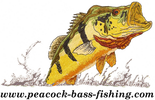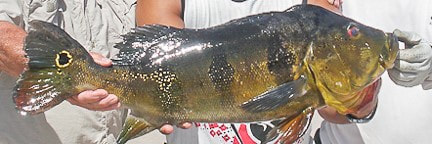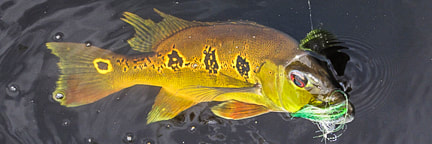Peacock Bass
The black water rivers of Brazil’s Amazon is home to over 2,500 species of fish, the most famous of which is the hard fighting Peacock Bass, the largest member of the African Cichlid family of fish. These powerful fighters are extremely aggressive producing devastating top water and subsurface action unlike any other freshwater fish in the world. You know you’re fishing for a bruiser when the guide hands you a heavy bait casting rod with a reel spooled with 65 - 80 lb test braided Kevlar line and a 6” top water lure with several 5/0 and 7/0 hooks hanging from it! Within the last 10 years the IGFA has expanded its listing of Peacock Bass to 11 distinct species scattered across South America.
You can expect to catch 3 or 4 species of Peacock Bass including the massive Paca/Acu variety weighing upwards of 30 lbs, the Orinoco weighing upwards of 16 lbs, the Butterfly Peacock weighing upwards of 10 lbs as well as the Popoca & Oscellris weighing up to 4 lbs. You can expect to catch 20 – 35 Peacocks per day while fishing the black water tributaries of Brazil’s Rio Negro, Rio Branco and Rio Madeira watersheds in the Amazon on the exclusive lands River Plate Anglers leases from the indigenous Indians.
In addition to Peacock Bass, anglers can catch two or three species of catfish (depending on the river they are fishing), some of which can top 200 lbs, prehistoric Arapaima & Arowana, several species of Piranha, Bicuda, Jacunda and a variety of Oscars. Most people target the Peacocks by casting big noisy top water lures, jerk baits and jigs with fly fishermen throwing streamers but they often catch a lot of “interesting” species in addition to Peacock Bass! Brazil's Amazon is the fresh water tropical fish capital of the world with over 2500 species of fish living in its waters.
You can expect to catch 3 or 4 species of Peacock Bass including the massive Paca/Acu variety weighing upwards of 30 lbs, the Orinoco weighing upwards of 16 lbs, the Butterfly Peacock weighing upwards of 10 lbs as well as the Popoca & Oscellris weighing up to 4 lbs. You can expect to catch 20 – 35 Peacocks per day while fishing the black water tributaries of Brazil’s Rio Negro, Rio Branco and Rio Madeira watersheds in the Amazon on the exclusive lands River Plate Anglers leases from the indigenous Indians.
In addition to Peacock Bass, anglers can catch two or three species of catfish (depending on the river they are fishing), some of which can top 200 lbs, prehistoric Arapaima & Arowana, several species of Piranha, Bicuda, Jacunda and a variety of Oscars. Most people target the Peacocks by casting big noisy top water lures, jerk baits and jigs with fly fishermen throwing streamers but they often catch a lot of “interesting” species in addition to Peacock Bass! Brazil's Amazon is the fresh water tropical fish capital of the world with over 2500 species of fish living in its waters.
Speckled/Paca & Three Bar/Acu
Cichla temensis
For many years people thought the Speckled and 3 Bar were two separate species of Peacock Bass but research in the last 10 years has shown that they are two different color phases of the same fish. When temensis is spawning they display the 3 Bar or in Portuguese “Azu” color phase and the remainder of the time they display the Speckled or in Porteguese “Paca” color phase. Fisherman have always stated that the Pacas fought harder than the Azus, this may be because the fish in the Acu color phase are in the active spawning cycle and thus do not have the energy the fish in the Paca color phase exhibit. It is interesting that two of the last 3 world records, a 28 & 29 lb fish have both been males with the spawning hump on their head in the 3 Bar spawning phase and the 27 lb previous record was a female sporting the non-spawning Paca color phase. Commercial fisherman have reported netting Peacocks upwards of 35 lbs, so there is very possibly a world record out there waiting for you! These monster Cichla temensis subspecies of Peacock Bass are found throughout Brazil, Venezuela and Columbia although the last 3 world records have been caught in Brazil’s Amazon. Temensis weighing in the mid to high teens are common with monsters weighing 20+ lbs not uncommon in areas where the fishing pressure is light. Believe me, a 15 lb temensis will give a battle you will long remember. These are structure oriented fish and once you stick them, the first 15 – 20 seconds trying to keep them out of the brush or structure produces a battle that is legendary!
Orinoco
Cichla orincensis
16.1 lb IGFA All Tackle World Record Caught
By George Walters
Orinoco peacocks can be distinguished from all other species of peacock bass by the presence of three large, dark ocellated blotches along their side and a lateral band of blotches between the last ocular spot on their body and the ocular spot on their tail. They are often confused with butterfly peacocks (Cichla ocellaris) that have just the three ocular spots on their sides because they are commonly called “burboleta”, which is Brazilian Portuguese for “butterfly”. The Orinoco Peacock will get quite a bit larger than the Butterfly Peacock Bass with the IGFA All Tackle World Record weighing 16.1 lbs caught by George Walters fishing with River Plate Anglers February of 2010!
Butterfly
Cichla orinocensis
The Butterfly Peacock Bass, called Borboleta in Portuguese, a prolific scrapper averaging 3 – 6 lbs with a big one reaching 10 lbs, can be caught across Central America and southern Florida as well. This subspecies has three predominant ocular spots on its sides as well as one on its tail. These fish can vary from gold to vivid green. When on their beds, they can be found by the hundreds in shallow lagoons. Butterflies will make a good account of themselves if you scale your tackle down from the heavy gear used for the bigger Pacas. With light spinning gear or a number 5 or 6 fly rod you can have a blast catching 50 – 100 of these beautiful scrappers per day on top water or subsurface baits as well as small streamers or top water poppers.
Popopca
Cichla intermedia
Popoca are a fairly prolific species of Peacock Bass in the upper Rio Negro watershed and some of its tributaries. I have fished waters where they are caught in big numbers and then in a tributary not 40 miles away found none. These little battlers will average 2 – 4 lbs with fish over 5 lbs being very unusual. When Popoca are spawning they will develop beautiful vivid red gill plates. They will also give a good account of themselves with light spinning or fly tackle.
Cichla oscellris
These little battlers resemble the Popoca in patterns and coloring but are much more subtly marked and do not have the very vivid orange gill plates that Popoca exhibit during spawning. They are caught in the upper Rio Branco watershed, but I have caught several, including the one in the picture above, in the upper Rio Negro watershed. Like a Popoca, they will general weigh 2 – 4 lbs with a 5 lber being a monster. Lots of fun on light tackle with either top water or subsurface baits.













